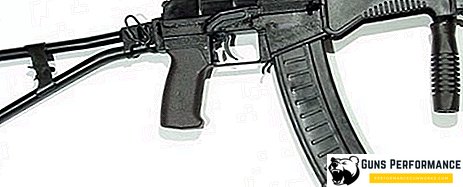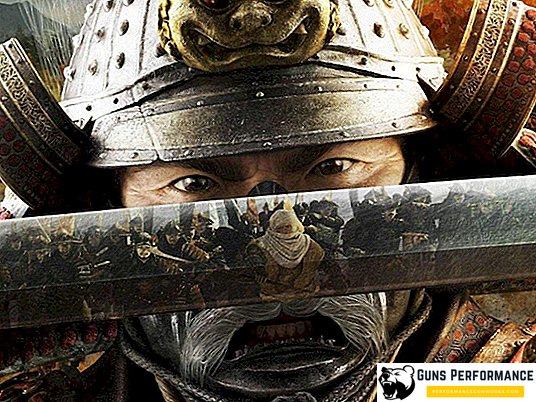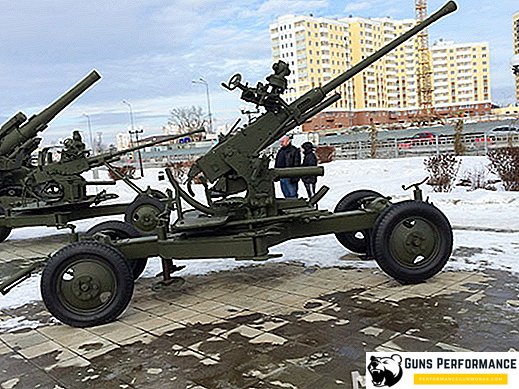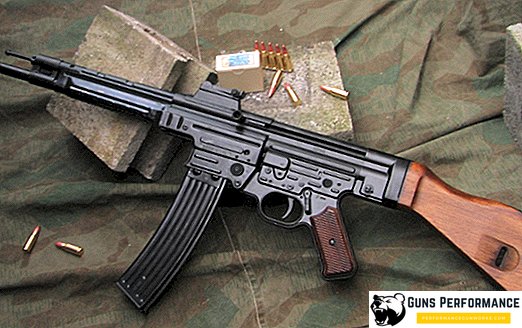
On April 24, 1915, in the front area near the town of Ypres, French and British soldiers noticed a strange yellow-green cloud that was rapidly moving towards them. It seemed that nothing foreshadowed trouble, but when this fog reached the first line of the trenches, people in it began to fall, cough, choke and die.
This day became the official date of the first massive use of chemical weapons. The German army on the front of a six-kilometer-wide front released in the direction of enemy trenches 168 tons of chlorine. The poison struck 15 thousand people, 5 thousand of them died almost instantly, and the survivors died later in hospitals or were disabled for the rest of their lives. After the use of gas, German troops went on the attack and without a loss took enemy positions, because there was no one to defend them.
The first use of chemical weapons was considered successful, so it soon became a real nightmare for the soldiers of the opposing sides. Combat poisoning substances were used by all the countries participating in the conflict: chemical weapons became a real "calling card" of the First World War. By the way, the city of Ypres was “lucky” in this respect: two years later, the Germans in the same locality used dichlorodiethyl sulfide against the French - a chemical weapon of blistering action, which was called “mustard”.
This small town, like Hiroshima, has become a symbol of one of the gravest crimes against humanity.
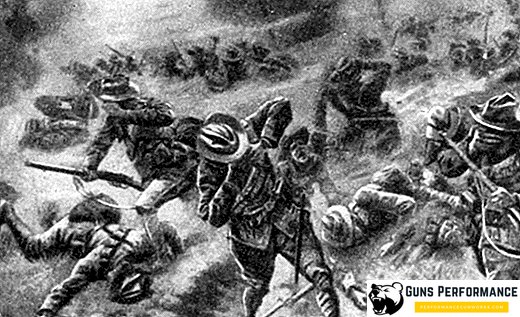
May 31, 1915 chemical weapons were first used against the Russian army - the Germans used phosgene. A cloud of gas was taken for camouflage and even more soldiers were transferred to the front edge. The consequences of the gas attack were terrible: 9 thousand people died a painful death, because of the effects of the poison, even the grass died.
Chemical weapons history
The history of chemical warfare agents (OM) has more than one hundred years. To poison enemy soldiers or temporarily disable them, various chemical compounds were used. Most often, such methods were used in the siege of fortresses, since it is not very convenient to use toxic substances during a maneuvering war.
For example, in the West (including Russia) they used artillery "stinking" cores that emitted suffocating and poisonous smoke, and the Persians used a mixture of sulfur and crude oil in the assault on cities.
However, to talk about the massive use of toxic substances in the old days, of course, was not necessary. Chemical weapons were considered by generals as one of the means of warfare only after they began receiving poisonous substances in industrial quantities and learned how to store them safely.
Certain changes were also required in the psychology of the military: as early as the 19th century, it was considered an ignoble and unworthy affair to poison its opponents as rats. Sulfur dioxide was used by the British military elite with indignation by the British admiral Thomas Gohran.
Curiously, chemical weapons were banned even before its mass use began. In 1899, the Hague Convention was adopted, which prohibits weapons that use asphyxiation or poisoning to kill an enemy. However, this convention did not prevent neither the Germans nor the other participants of the First World War (including Russia) to use poison gases en masse.

Already during the First World War, the first methods of protection against poisonous substances appeared. At first they were different dressings or capes, impregnated with various substances, but they usually did not give the proper effect. Then gas masks were invented, in appearance resembling modern ones. However, gas masks at first were far from perfect and did not provide the necessary level of protection. Special gas masks have been developed for horses and even dogs.
Not standing still and means of delivery of toxic substances. If at the beginning of the war, gas was simply sprayed from cylinders toward the enemy, then then artillery shells and mines were used to deliver weapons. New, more deadly types of chemical weapons have appeared.
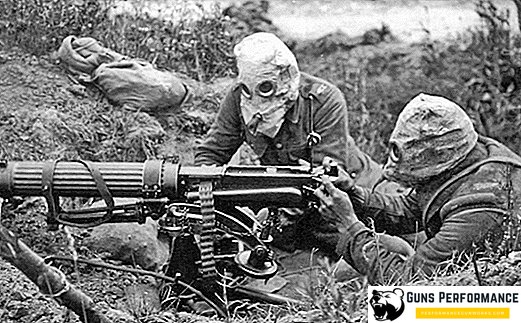
After the end of the First World War, work in the field of the creation of poisonous substances did not stop: methods for the delivery of chemical agents and methods of protection against them improved, new types of chemical weapons appeared. Tests of combat gases were regularly conducted, special shelters were built for the population, soldiers and civilians were trained to use personal protective equipment.
In 1925, another convention was adopted (the Geneva Pact), which prohibited the use of chemical weapons, but this in no way stopped the generals: they had no doubt that the next major war would be chemical, and they were intensively preparing for it. In the mid-thirties, nerve gases were developed by German chemists, the effects of which are the most deadly.
However, the Second World War did not become a gas war: the participants in the conflict did not dare to begin the mass use of toxic substances. Nevertheless, the Hitlerites actively used gases against defenseless prisoners of concentration camps, using the substance Cyclone-B for these purposes.
After the end of the war, several cases of the use of agents in local conflicts were recorded. The Americans used in Vietnam defoliant "Agent Orange", which included dioxin - one of the most poisonous substances, besides having the strongest mutagenic effect. However, the purpose of such actions was still the masking foliage of the trees, and not the partisans.
There is information about the use of Soviet troops during the war in Afghanistan.
Toxic agents were used during the Iran-Iraq conflict (by both sides), in the civil conflict in Yemen, chemical weapons were used by Iraqi government forces during the suppression of Kurdish uprisings. The parties to the Syrian conflict constantly accuse each other of using prohibited chemical substances.
The USSR and the USA accumulated chemical arsenals and developed new types of toxic substances for decades, but, fortunately, they have not yet taken advantage of them. In the early 1990s, Russia had the world's largest arsenal of toxic agents, but by 2013, three-quarters of these reserves were disposed of.
In 1993, another chemical weapons convention was adopted. It declared the complete prohibition of the manufacture, storage and use of these weapons of mass destruction and the gradual destruction of the previously created stocks of chemical weapons. Currently, almost all countries of the world, including the United States and Russia - the countries with the largest reserves of organic substances, have joined this convention.
Fortunately, the 20th century did not become a period of global chemical wars, no matter how it may seem at its beginning. However, one should not attribute this fact to the victory of common sense or the ideas of humanism. It is all about the features of chemical weapons and how to use them, as will be discussed below. Moreover, despite the formal prohibition, the development of chemical weapons is going on in many states, although it is not publicized, tests are being conducted, methods of delivering chemical weapons are being improved.
Types and types of chemical weapons
Chemical weapons are chemical warfare agents plus means for their delivery and use. There are several classifications of this type of weapons of mass destruction, based on various features: the physiological effects of agents, their tactical purpose, durability and speed of impact on the human body.
By the duration of their ability to damage the human body, toxic substances are divided into two types:
- unstable or volatile;
- persistent.
The first group includes hydrocyanic acid and phosgene. They can defeat only within a few minutes after application. Toxic substances are considered to be persistent, the effect of which can last for hours and even days - for example, mustard gas and lewisite.
Toxic substances differ in their tactical purpose. This classification is based on the results of exposure to humans. Fighting gases are lethal (most of the chemical weapons) and temporarily disabling the enemy's manpower. The latter include psychotropic substances and irritant agents. Currently, irritating gases are actively used by law enforcement agencies in various countries to disperse demonstrations and end riots.
However, even non-lethal gases in high concentrations can be fatal.
The main classification of toxic substances is based on the effect of gas on the human body. This is the main characteristic of chemical weapons. There are six types of agents:
- Nerve paralytic gases. These substances are the most dangerous, they affect the human nervous system and even in low concentrations lead to his death. Such gases include sarin, soman, herd, V-gases. Some of them act through the skin, have no smell and color. When the victim has signs of nerve gas poisoning, it is usually too late to do anything.
- Toxic substances blistering action. Skin and respiratory organs are affected. To protect against them gas mask is not enough, you need a special suit. Such gases include mustard gas, lewisite.
- OB general action. Once in the human body, they act on red blood cells and impair their ability to transport oxygen to tissues. This group includes hydrocyanic acid and chlorocyan. A distinctive feature of such substances is the speed of their action. They cause death in a matter of minutes.
- Gas asphyxiation. They affect the respiratory system, which leads to painful death. This group of chemical weapons includes phosgene, diphosgene, chlorine.
- Toxic substances psychotropic or psychochemical action. These substances are often used not for the lethal damage of enemy personnel, but for long-term disabling it. Substances affect the central nervous system and cause short-term mental disorders in humans. The result of their impact may be deafness, blindness, inability to move, unmotivated feelings of anxiety and fear. Usually they do not lead to death.
- Irritant irritant. These include various tear gases, substances that cause profuse coughing, sneezing. There are also products that have an unbearably unpleasant odor. These gases are not lethal, they act very quickly, but their exposure time is limited. Actively used by law enforcement.
Another classification of agents is the speed of their effects on the human body. There are fast-acting agents (sarin, herd, prussic acid) or slow-acting (that is, having a latent period of effects on the body): mustard gas, phosgene, adamsite.
Reasons for refusing chemical weapons

Despite the deadliness and significant psychological effect, today we can confidently say that chemical weapons are a past stage for humanity. And the point here is not in the conventions that prohibit the persecution of their own kind, and even not in public opinion (although it also played a significant role).
The military practically abandoned poisonous substances, because chemical weapons have more drawbacks than advantages. Let's look at the main ones:
- Strong dependence on weather conditions. At first, poison gases were released from cylinders downwind in the direction of the enemy. However, the wind is changeable, so during the First World War there were frequent cases of the defeat of their own troops. Use as a method of delivering artillery ammunition solves this problem only partially. Rain and simply high humidity dissolves and decomposes many toxic substances, and air ascending currents carry them high into the sky. For example, the British in front of their line of defense made numerous bonfires, so that the hot air carried the enemy gas up.
- Storage safety. Conventional ammunition without a detonator detonate extremely rarely, which is not true of projectiles or tanks with agents. They can lead to mass casualties, even being deep in the rear in a warehouse. In addition, the cost of their storage and disposal is extremely high.
- Protection. The most important reason for abandoning chemical weapons. The first gas masks and dressings were not very effective, but soon they provided quite effective protection against agents. In response, chemists came up with blistering gases, after which a special chemical protection suit was invented. In armored vehicles appeared reliable protection against any weapons of mass destruction, including chemical ones. In short, the use of chemical warfare agents against the modern army is not very effective. That is why in the last fifty years, OS has been more often used against civilians or partisan detachments. In this case, the results of its use were really terrifying.
- Inefficiency. Despite all the horror that the battle gases caused to the soldiers during the Great War, an analysis of casualties showed that conventional artillery fire was more effective than firing weapons with weapons. The projectile, filled with gas, was less powerful, so worse destroyed the engineering structures and barriers of the enemy. The surviving fighters quite successfully used them in defense.
Today, the greatest danger is that chemical weapons may end up in the hands of terrorists and will be used against civilians. In this case, the victims can be terrifying. Combat toxic agent is relatively easy to manufacture (as opposed to nuclear), and it is cheap. Therefore, the threats of terrorist groups against possible gas attacks should be treated very carefully.
The biggest drawback of chemical weapons is their unpredictability: where the wind will blow, whether the humidity will change, which way the poison goes along with the groundwater. In whose DNA mutagen is inserted from war gas, and whose child will be born crippled. And these are not theoretical questions at all. American soldiers, who became cripples after using their own gas, Agent Orange in Vietnam, are clear evidence of the unpredictability that chemical weapons carry.


